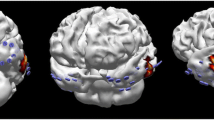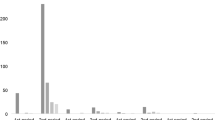Abstract
The aim of this study was to determine whether the occurrence of focal to bilateral motor seizures in the course of partial drug withdrawal during video-EEG monitoring (FTBMS-M) had a predictive value for seizure recurrence in surgically treated patients with mesial temporal lobe epilepsy (MTLE). We analyzed the outcomes of 59 patients who underwent temporal lobe resection at 12 month postoperative follow up. In total, 48 out of 59 patients were rendered seizure free (81.4%). We analyzed seizure recurrence after surgery with reference to: (i) occurrence of seizures after partial drug withdrawal during video-EEG monitoring (FTBMS-M); (ii) history of secondarily generalized seizures during antiepileptic drug treatment prior to presurgical evaluation (FTBMS-H) and (iii) other possible confounding factors (sex, age, epilepsy duration, side of surgery, presence of hippocampal sclerosis, and history of febrile seizures). We found no differences in the frequency of seizure recurrences between patients with FTBMS-M and patients without FTBMS-M (4/20 vs. 7/39; p = 0.848). Conversely, the frequency of seizure recurrence was significantly higher among the patients with FTBMS-H than among the patients without FTBMS-H (7/20 vs. 4/39; p = 0.021). The predictive value of FTBMS-H for postoperative seizure recurrence was confirmed in logistic regression analysis. We found a statistically significant influence of FTBMS-H on poor outcome after surgery, but not of FTBMS-M or other confounding variables, which suggests that withdrawal seizures do not affect postsurgical seizure control.

Similar content being viewed by others
Availability of data and material
The authors consent to making raw data available for examination and further analysis upon request.
References
Semah F, Picot MC, Adam C, Broglin D, Arzimanoglou A, Bazin B et al (1998) Is the underlying cause of epilepsy a major prognostic factor for recurrence? Neurology 51(5):1256–1262
Engel J (1996) Surgery for seizures. N Engl J Med 334(10):647–652
Wiebe S, Blume WT, Girvin JP, Eliasziw M (2001) Effectiveness and Efficiency of Surgery for Temporal Lobe Epilepsy Study Group. A randomized, controlled trial of surgery for temporal-lobe epilepsy. N Engl J Med 345(5):311–318
Dupont S, Tanguy M-L, Clemenceau S, Adam C, Hazemann P, Baulac M (2006) Long-term prognosis and psychosocial outcomes after surgery for MTLE. Epilepsia 47(12):2115–2124
Tanriverdi T, Olivier A, Poulin N, Andermann F, Dubeau F (2008) Long-term seizure outcome after mesial temporal lobe epilepsy surgery: corticalamygdalohippocampectomy versus selective amygdalohippocampectomy. J Neurosurg 108(3):517–524
Ebner A (2000) Preoperative evaluation in epilepsy surgery: some principal considerations. In: Lüders H (ed) Epilepsy surgery. Lippincott-Raven, Philadelphia, pp 177–183
Hennessy MJ, Elwes RD, Rabe-Hesketh S, Binnie CD, Polkey CE (2001) Prognostic factors in the surgical treatment of medically intractable epilepsy associated with mesial temporal sclerosis. Acta Neurol Scand 103(6):344–350
Spencer SS, Berg AT, Vickrey BG, Sperling MR, Bazil CW, Shinnar S et al (2005) Predicting long-term seizure outcome after resective epilepsy surgery: the multicenter study. Neurology 65(6):912–918
Jeha LE, Najm IM, Bingaman WE, Khandwala F, Widdess-Walsh P, Morris HH et al (2006) Predictors of outcome after temporal lobectomy for the treatment of intractable epilepsy. Neurology 66(12):1938–1940
Jeong S-W, Lee SK, Hong K-S, Kim K-K, Chung C-K, Kim H (2005) Prognostic factors for the surgery for mesial temporal lobe epilepsy: longitudinal analysis. Epilepsia 46(8):1273–1279
Fong JS, Jehi L, Najm I, Prayson RA, Busch R, Bingaman W (2011) Seizure outcome and its predictors after temporal lobe epilepsy surgery in patients with normal MRI. Epilepsia 52(8):1393–1401
McIntosh AM, Kalnins RM, Mitchell LA, Fabinyi GCA, Briellmann RS, Berkovic SF (2004) Temporal lobectomy: long-term seizure outcome, late recurrence and risks for seizure recurrence. Brain J Neurol 127(Pt 9):2018–2030
Spencer SS, Spencer DD, Williamson PD, Mattson RH (1981) Ictal effects of anticonvulsant medication withdrawal in epileptic patients. Epilepsia 22(3):297–307
So EL, Fisch BJ (1997) Drug withdrawal and other activating techniques. Epilepsy: a comprehensive textbook. Lippincott-Raven, Philadelphia, pp 1021–1027
Zhou D, Wang Y, Hopp P, Kerling F, Kirchner A, Pauli E et al (2002) Influence on ictal seizure semiology of rapid withdrawal of carbamazepine and valproate in monotherapy. Epilepsia 43(4):386–393
Janszky J, Janszky I, Schulz R, Hoppe M, Behne F, Pannek HW et al (2005) Temporal lobe epilepsy with hippocampal sclerosis: predictors for long-term surgical outcome. Brain J Neurol 128(Pt 2):395–404
Jehi LE, Silveira DC, Bingaman W, Najm I (2010) Temporal lobe epilepsy surgery failures: predictors of seizure recurrence, yield of reevaluation, and outcome following reoperation. J Neurosurg 113(6):1186–1194
French JA, Williamson PD, Thadani VM, Darcey TM, Mattson RH, Spencer SS, et al. (1993) Characteristics of medial temporal lobe epilepsy: I. Results of history and physical examination. Ann Neurol 34(6):774–780.
Wieser H-G (2004) ILAE commission on neurosurgery of epilepsy. ILAE Commission Report. Mesial temporal lobe epilepsy with hippocampal sclerosis. Epilepsia 45(6):695–714.
Cook MJ, Fish DR, Shorvon SD, Straughan K, Stevens JM (1992) Hippocampal volumetric and morphometric studies in frontal and temporal lobe epilepsy. Brain J Neurol 115(Pt 4):1001–1015
Savic I, Altshuler L, Baxter L, Engel J (1997) Pattern of interictal hypometabolism in PET scans with fludeoxyglucose F 18 reflects prior seizure types in patients with mesial temporal lobe seizures. Arch Neurol 54(2):129–136
Popovic L, Vojvodic N, Ristic AJ, Bascarevic V, Sokic D, Kostic VS (2012) Ictal dystonia and secondary generalization in temporal lobe seizures: a video-EEG study. Epilepsy Behav EB 25(4):501–504
Dinner DS, Neme S, Nair D, Montgomery EB, Baker KB, Rezai A et al (2002) EEG and evoked potential recording from the subthalamic nucleus for deep brain stimulation of intractable epilepsy. Clin Neurophysiol Off J Int Fed Clin Neurophysiol 113(9):1391–1402
Spencer SS (2002) Neural networks in human epilepsy: evidence of and implications for treatment. Epilepsia 43(3):219–227
Blume WT (1978) Clinical and electroencephalographic correlates of the multiple independent spike foci pattern in children. Ann Neurol 4(6):541–547
Najm I, Jehi L, Palmini A, Gonzalez-Martinez J, Paglioli E, Bingaman W (2013) Temporal patterns and mechanisms of epilepsy surgery failure. Epilepsia 54(5):772–782
Doležalová I, Brázdil M, Hermanová M, Janoušová E, Kuba R (2014) Effect of partial drug withdrawal on the lateralization of interictal epileptiform discharges and its relationship to surgical outcome in patients with hippocampal sclerosis. Epilepsy Res 108(8):1406–1416
Acknowledgements
Dedicated to the memory of Robert Kuba from the Brno Epilepsy Center. He will live on in our hearts forever. The authors wish to thank Ivan Soldatović and Ognjen Milićević for statistical analysis. Also, many thanks go Tto Anne Johnson for grammatical assistance and language editing.
Funding
The research was conducted at The Neurology Clinic, Clinical Center of Serbia in cooperation with The Neurology Department of Faculty of Medicine, University of Belgrade as a part of regular research activities. There was no external funding.
Author information
Authors and Affiliations
Contributions
All authors contributed to the study conception and design. Material preparation, data collection and analysis were performed by MK, NV and AR. The first draft of the manuscript was written by NV and all authors commented on previous versions of the manuscript. All subsequent manuscript editions were written by MK. All authors read and approved the final manuscript.
Corresponding author
Ethics declarations
Conflicts of interest
The authors have no conflicts of interests or competing interests to declare.
Ethics approval
The study was performed in accordance with the ethical standards as laid down in the 1964 Declaration of Helsinki and its later amendments or comparable ethical standards. Since the research was performed retrospectively, the authors were not required to obtain formal ethics approval.
Consent to participate
Patients were offered a written consent form for participation in this as well as further research. Subjects were informed that declining to participate in research and publication would not influence the course of their treatment. All the subjects included were compliant with their information being used for research purposes, which was verified with their hand signature or hand signature of their legal guardian when applicable.
Consent for publication
The study subjects provided informed consent for publication of their data in the previously mentioned written consent form.
Additional information
Publisher's Note
Springer Nature remains neutral with regard to jurisdictional claims in published maps and institutional affiliations.
Rights and permissions
About this article
Cite this article
Kovačević, M., Sokić, D., Ristić, A.J. et al. Focal to bilateral motor seizures in temporal lobe epilepsy during video-EEG monitoring: effects on surgical outcome. Acta Neurol Belg 121, 1677–1684 (2021). https://doi.org/10.1007/s13760-020-01471-7
Received:
Accepted:
Published:
Issue Date:
DOI: https://doi.org/10.1007/s13760-020-01471-7




